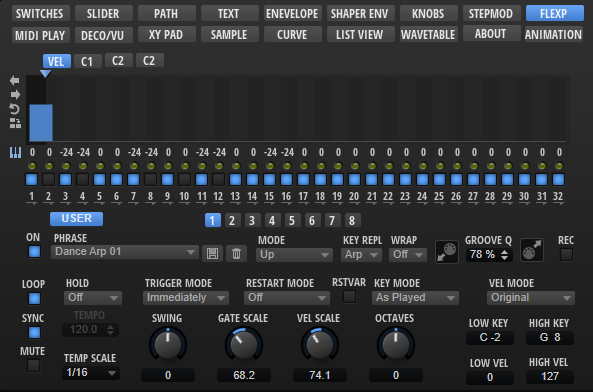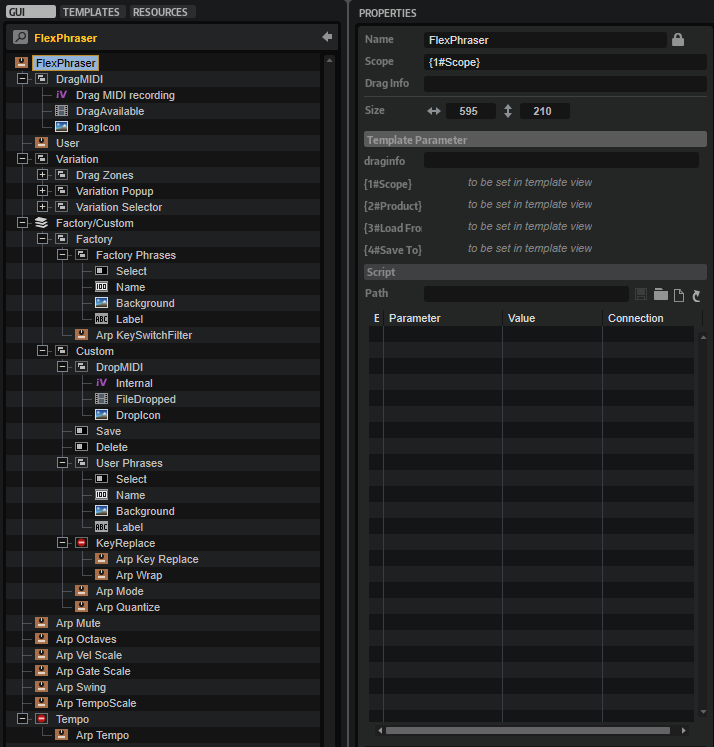/ HALion Developer Resource / HALion Macro Page / Templates /
FlexPhraser
On this page:

Description
The FlexPhaser template contains controls for selecting the phrases, adjusting the performance parameters like Swing, Gate Scale, etc., and for using the eight variations of the FlexPhraser MIDI module. In addition, there are controls for recording the MIDI output of the FlexPhraser and to export the recorded phrase via drag and drop.
Functionality such as using the eight variations, exporting the recorded MIDI output, etc., cannot be realized with standard macro page controls. The Internal control is used if this is the case. The performance parameters like Swing, Gate Scale, Vel Scale, etc. are connected to the eight variations by corresponding UI variables and they must be part of this template. To ensure the operation of the performance parameters, the eight variations and the MIDI phrase export, the preconfigured properties must not be modified. The look and the size of the controls can be modified freely. All controls for functions that are not needed for your instrument can be omitted on your macro page.
To explore the functionality and connections:
- Load the Init Basic Controls.vstpreset from the Basic Controls library.
- Open the Macro Page Designer, go to the GUI Tree and navigate to "Pages > FlexPhraser Page > Arp Parameter".
- Select "FlexPhraser View" and click Edit Element
to examine the template.
❕ The other control templates inside the Arp Parameter group are directly connected to the FlexPhraser MIDI module and do not require detailed explanation. The control template for creating User phrases can be found in the StepSEQ group. See FlexPhraserStepSeq for details.
Template Properties
| Poperty | Description |
|---|---|
| Name | The name of the element. This name will be displayed in the GUI Tree. |
| Position/Size | Position X, Position Y, Width, Height: Position and size of the element in pixels. Position X/Y defines the position of the upper left corner. |
| Attach | Defines how an element behaves when its parent element is resized. You can set the following parameters:
|
| Tooltip | Text that appears as a tooltip when the mouse hovers over the element. |
| Template | Determines the template to be referenced. |
Template Parameters
| Parameter | Description |
|---|---|
| Scope | Defines the path to the FlexPhraser MIDI module to be controlled. For example: @0:FlexPhraser controls the first FlexPhraser in the program. |
| Product | Product specifies the root folder for the location of the subpresets, both for loading and saving. Set this to HALion if you want to load phrases from the standard file path for subpresets. Load From (see below) must be set to StepSEQ Phrases, which specifies the path to the folder that contains the subpresets for the phrases. When saving User phrases, these will be written to ./Documents/Steinberg/HALion/Sub Presets/StepSEQ Phrases on hard disk. They are displayed with a user icon in the phrase selector.If you want to deliver your own phrases as part of your library, you can set Product to the name of your instrument, e.g., You can also include both, the HALion root folder and the root folder of your instrument, by setting Product to |
| Load From | Load From specifies the subpath to the location of the subpresets inside the root folder. The root folder is set by Product (see above). You can specify this subfolder freely. However, if you want to see the factory phrases, Load From must be set to StepSEQ Phrases and Product must contain HALion.Any phrases you want to distribute with your library must be added to the corresponding location inside the VST Sound. For example, if Load From is set to |
| Save To | Allows you to specify the subpath to the location where the subpresets will be saved by default.
|
❕ If you need further control over the content locations, you can specify the required subfolder together with the Product:
MyProductName/StepSEQ Phrases|HALion/StepSEQ Phrases. See configuration 4 in the following table.
Content Locations for Different Configurations
| # | Configuration | Content in Phrase Selector | Default Save Path |
|---|---|---|---|
| 1 | Product = Load From = Save To = | Only phrases from HALion, including any phrases the user has saved on hard disk. | ./Documents/Steinberg/HALion/Sub Presets/StepSEQ Phrases/MySubfolder |
| 2 | Product = Load From = Save To = | Only phrases from the specified library, including any phrases the user has saved with the instrument on hard disk. | ./Documents/Steinberg/MyProductName/Sub Presets/StepSEQ Phrases/MySubfolder |
| 3 | Product = Load From = Save To = | All phrases from HALion, the specified library and any phrases the user has saved on hard disk. | ./Documents/Steinberg/MyProductName/Sub Presets/MyProductName/MySubfolder |
| 4 | Product = Load From = deactivate, leave empty Save To = | All phrases from HALion, the specified library and any phrases the user has saved on hard disk. | ./Documents/Steinberg/MyProductName/Sub Presets/StepSEQ Phrases/MySubfolder |
❕ The location of the phrases inside the VST Sound must match the path defined by Product and Load From, otherwise the phrase selector will not see these phrases. If libraries deliver phrases in multiple VST Sounds, all phrases with the same path will be shown together in the phrase selector.
Components inside the Template
Controls and Subtemplates
To ensure the operation of the controls and subtemplates, the preconfigured properties must not be modified. The look and the size of the controls can be modified freely. All controls for functions that are not needed for your instrument can be omitted on your macro page.
| Item | Description |
|---|---|
| DragMIDI | This Group contains controls for recording the MIDI output of the FlexPhraser and to export the recorded phrase via drag and drop.
|
| User | A switch template that allows you to activate the User mode for the current variation. Its Value must be set to @UserMode. |
| Variation | A Group with three subgroups that provide the necessary elements to switch between variations, to drag variations to the trigger pads, and to open the context menu of the variation switches. The aformentioned functionalities are implemented by Internal controls. Their preconfigured properties should not be modified. Also, the z-order of the subgroups in the GUI Tree is not supposed to change. "Drag Zones" must be topmost, followed by "Variation Popup", and then "Variation Selector" as bottommost group.
|
| Factory/Custom | A Stack containing two pages with controls to manage either the FlexPhraser factory phrases or the User phrases.
|
| Arp Mute | A switch template that allows you to mute the variation. Its Value must be set to @Mute. |
| Arp Octaves | A knob template that adjusts the octave range of the variation. Its Value must be set to @OctaveRange. |
| Arp Vel Scale | A knob template that adjusts the velocity scale of the variation. Its Value must be set to @VelocityScale. |
| Arp Gate Scale | A knob template that adjusts the gate scale of the variation. Its Value must be set to @GateScale. |
| Arp Swing | A knob template that adjusts the swing of the variation. Its Value must be set to @Swing. |
| Arp TempoScale | A value box template that adjusts the note value of the tempo scale of the variation. Its Value must be set to @TempoScale. |
| Tempo | A Disable control that specifies whether the contained "Arp Tempo" template is active. Its Value must be set to @Sync.
|
